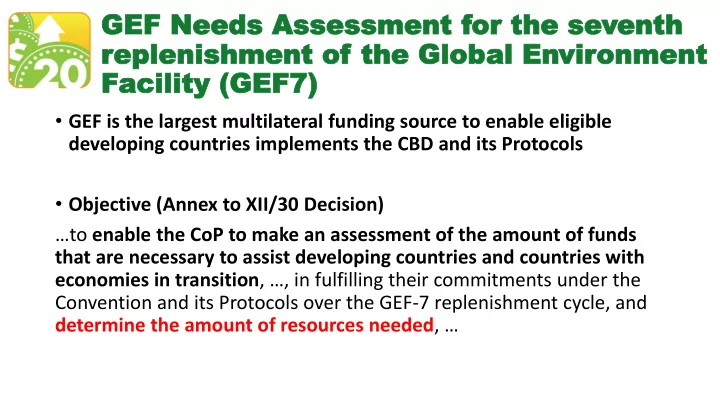

GEF GEF Needs Assessment Needs Assessment for the se or the seventh enth replenishmen eplenishment t of of the Glob the Global E al Envir vironment onment Facility ( acility (GEF7) GEF7) • GEF is the largest multilateral funding source to enable eligible developing countries implements the CBD and its Protocols • Objective (Annex to XII/30 Decision) … to enable the CoP to make an assessment of the amount of funds that are necessary to assist developing countries and countries with economies in transition , …, in fulfilling their commitments under the Convention and its Protocols over the GEF-7 replenishment cycle, and determine the amount of resources needed , …
Frequently Asked Questions Q1. Why respond to the questionnaire regarding GEF-7 funding needs assessment? • The questionnaire main tool to assess the funding needs for GEF • The assessment will use the GEF-6 STAR Country Allocations for the Biodiversity Focal Area as the baseline, and look into the justifications for funding needs of each country during the GEF-7 period • In case of no information Team of Experts will have to assume that no change of GEF funding is required from the country for the GEF-7 period. Q2. How have other recipient countries responded to the questionnaire? • Submissions have been posted at the website: https://www.cbd.int/financial/survey2016.shtml • The questionnaire follows GEF project proposal ideas • The Expert Team developed a guidance : https://www.cbd.int/financial/gef/cbd-gef-7-funds-needs-questionnaire- guide-en.pdf.
• Few lessons learned so far: (1) Consistency between estimated total project costs, co-financing options from national and other sources, and expected funding from GEF-7. (2) Expected funding from the GEF should be based on INCREMENTAL COST REASONING . (3) All columns should be completed in full, and there should be no empty cells. (4) When compiling project ideas for GEF-7 period 2018-2022, take into account the absorption capacity of the country and the delivery capacity of the GEF agencies that operate in the country. The tables about GEF 6 planned and approved projects should give an indication in that regard. Q3. I found it very difficult to indicate domestic funding as the Ministry of Finance does not have concrete figures yet. • The information requested for the questionnaire is INDICATIVE and does not imply firm commitments. • GEF as the financial mechanism of the Convention was designed to meet the agreed full incremental costs in accordance with Article 21 of the Convention, and as the practice, the final commitments of all involved parties have been a result of iterative negotiations between the GEF and recipient countries.
Q4. Will my country's response to the questionnaire affect my country’s GEF - 7 allocation? • There is no causal link between responses to the questionnaire and GEF-7 allocations for individual countries. Your response to the questionnaire will support COP-13 in Mexico better understand the funding needs of your country, and communicate an appropriately informed assessment report to the Council of the GEF for consideration in the replenishment process for GEF-7. Q5. My country has not made use of GEF-6 country allocations. Should my country respond to the questionnaire regarding GEF 7 funding needs? • A5: Yes, please respond, because the assessment of GEF-7 funding needs provides an opportunity for your country to express the expected funding needs in the GEF-7 period 2018-2022.
Q6. My country has not finalized the revision, or updated, national biodiversity strategy and action plan (NBSAP). Can my country still respond to the questionnaire? • Yes, responding to the questionnaire should be considered as a financial needs assessment for the period 2018-2022, based on activities that may be included in the revision of your national biodiversity strategy and action plan (NBSAP). Q7. The national biodiversity strategy and action plan of my country (NBSAP) only covers up to the year 2020. How can my country respond to the questionnaire for the period of time 2018-2022? • National biodiversity strategies and action plans (NBSAP) basically cover the period of time up to the year 2020, coinciding with the global Strategic Plan 2011-2020. However, the time span of projects arising out of NBSAPs or other national priorities may go beyond the set 2020 planning period.
Q8. What is the difference between the questionnaire and the financial reporting framework? • The financial reporting framework requests broad information on funding needs and gaps, and the questionnaire only requires information regarding funding needs that are expected to be covered by GEF during the specific period of time 2018-2022 . Q9. How will my country's response be used in the GEF-7 funding needs assessment? • All responses to the questionnaire from GEF recipient countries will be posted at: https://www.cbd.int/financial/survey2016.shtml for the purposes of transparency and consultation. • The Team of Experts will analyze and assess submissions from each country, and prepare a draft report for consideration at the first meeting of the Subsidiary Body of Implementation (SBI-1) in May 2016 and a final report for COP-13. Therefore, your responses are of utmost importance to inform an adequate decision of COP-13.
Recommend
More recommend